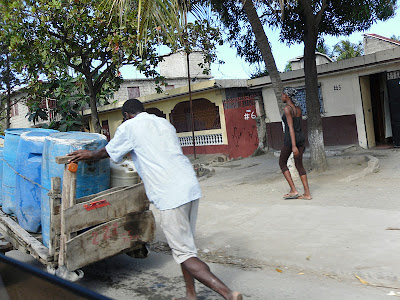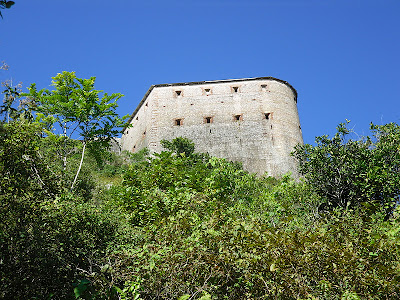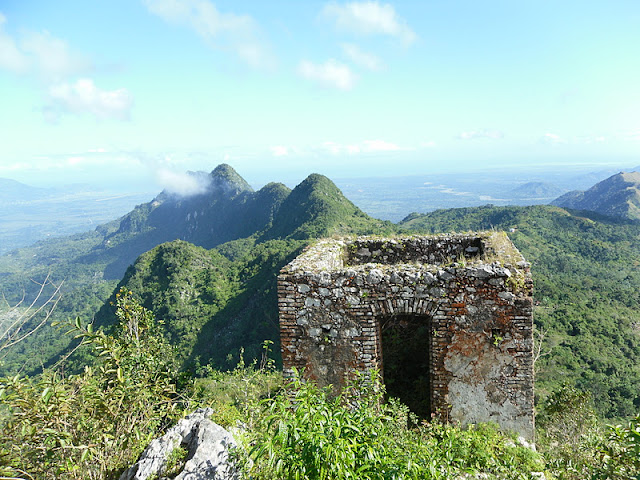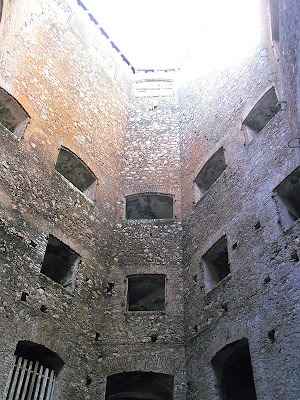From the upstairs balcony at the clinic, you can see the mountain known as Bonnet a L'Eveque, the smaller one on the right. The strange shape of the summit is actually a gigantic fortress built by Christophe (remember him?) called The Citadel. It is visible from much of this part of northern Haiti.
On our second Saturday in Haiti, we were lucky enough to pay it a visit. Sarah arranged for ten of us to rent two cars and drivers to take us almost to the top of that mountain. We drove for an hour or so, through the village of Milot that lies at the base of the mountain and then up a narrow, winding road to what is known as the "second parking lot". I never did find out where the first parking lot resides! By the time we got there the radiators on the cars were steaming away merrily, but the drivers paid them no heed.
Shortly after we left Milot, we were pulled over by some men on a couple of motorbikes. They extorted $5 from each of us (well, I guess that's the cost for foreigners to enter, but the manner of the request felt like extortion) and we were back on our way. As soon as we exited the cars in the parking lot, we were surrounded by Haitians who were selling tourist trinkets and food. I told one lady that I would buy a couple of maracas from her when I came back down and it seemed to pacify her, but it didn't stop the rest of the vendors from harassing me as I started up the hill.
Jennifer, the president of the board, had arrived the day before. Here we are, beginning the ascent. Note how small the Citadel appears at this point.
It was a beautiful day, sunny but not too hot, with occasional clouds floating in the sky.
A local Haitian man attached himself to each one of us, apparently appointing himself as a personal guide. I tried to tell mine that I didn't want a guide, but it was a lost cause. Other men, leading small horses, tagged along as well, apparently hoping that we were too wimpy to make the climb.
Ha! I showed them!
It was hot and steep, but I made it to the top in good time, ignoring all of the food vendors that lined the path along the way. There were houses all along the path, which I couldn't figure out. They kind of hang on the side of the mountain with no visible support. Banana and citrus and avocado trees are planted on the steep cliffs. Again, I have no idea how the fruit is harvested. Yet there is a whole mountainside community that somehow lives and eats and does their laundry in this seemingly inhospitable environment.
When we arrived at the top, our guides guilted us into paying them. I didn't give mine much, because I had warned him that I didn't want him. Dolly, on the other hand, had been lagging at the back, and her guide told her that $20 is the normal amount of payment, so she gave it to him. Luckily, it was all the money she had in her pocket, so at least she was safe from any more extortion or guilt-induced beneficence.
The guides tell some fantastic stories, but much of Haiti's history is difficult to authenticate and I have an inkling that they fabricate some of the tales. This much is certain. It is the largest fortress in the Americas and is part of a series of fortifications that was built as a defense after the slave rebellion in case the French ever tried to regain control of Haiti. It was built by about 20,000 workers between the years 1805 and 1820. It must have been an astounding feat of engineering and labour, as the mountain is 3,000 feet high and very steep.
When Christophe commissioned the fortress, he was a general in the Haitian army in charge of the northern regions. He and fellow conspirator Alexandre Petion led a coup against Haiti's emporer, Jean-Jacques Dessalines. The result was a divided Haiti, with Christophe ruling the north and Petion ruling the south.
One of the outstanding features of the fortress is the cannons, of which there were originally 365. There are still enormous stockpiles of cannonballs throughout the structure. The Citadel has withstood many earthquakes, but has never had to stand against a French attack.
The views are breath-taking and you will please pardon me for subjecting you to a plethora of them.
Everywhere you turn there are walls with no barriers to a precipitous fall.
Lovin' my Einstein hair, which was even worse this day because it was combined with hat-head!
There was another guide who was determined to lead our group through the entire Citadel, but I lagged purposefully behind. This was one of the first areas as we entered the walls. It's shape was whimsical, but I'm sure it was of great utility in its time.
The stone floor was damp and slippery with moss. The foundation of the fortress was built right into the stone of the mountaintop and fastened with a mortar made of quicklime, molasses, and the blood of local goats and cows. There is no symmetry to the design, which includes storage space for enough food and supplies for 5,000 defenders for a year.
Emergency preparedness at its finest!
No roof at the top, but the open space gives you an idea of the shape of this area.
Most of the following pictures are just places that I liked but have no idea of the purpose they served.
We spent a pleasant couple of hours wandering around. Every now and then a Haitian would try dogging my footsteps and talking to me, but I studiously ignored them.
The walls are all pitted and covered in variegated lichens. The outside walls have holes in them, I suppose for guns. Some are unfettered by weeds and you can see through them for miles.
Other holes, like these, serve no other visible purpose than to be homes for geckos, of which there were many.
Some areas reminded me of Labrynth, in the staircase scene.
Cannonballs are everywhere, should you ever need one.
And lovely old cannons. This was the one time I regretted not taking my good camera, as the lighting inside was a little difficult to work with, such bright light through the windows but dim in the recesses of the rooms.
Some of the cannons had intricate designs in their casting.
Up in the sunlight again.
Sarah found herself a quiet spot.
This was a huge cooking pot on top of a fire pit. It was probably four feet across.
More Escher-esque design.
I think this was a system for the water, but don't quote me on that. It was the topmost part of the fortress and we were walking along the edges, high above the ground.
Jennifer bought a flute and the guy was teaching her how to play it.
On the way back down the mountain, I made Dolly link arms with me. Her flip-flops were not serving her well on the treacherous path and I also wanted to protect her from the voracious vendors. We passed many more vendors and musicians on the way back down. First there was a group of men playing pipes, which we walked resolutely past. Then around a couple of corners was a group of young boys playing the same instruments. That was more difficult to ignore, but on we marched. Lots of fruit and snack vendors. Then, an old man playing a flute. He followed us for a long way, playing Auld Lang Syne over and over and over again. Later, we saw him in the parking lot, still playing the same song.
As we neared the parking lot, I could see that we were the first of our group to descend the mountain and I knew we were in trouble. Sure enough, we had to endure the solicitations of the vendors, who were increasingly insistent that we buy their wares, for about 30 minutes. One lady sidled right up next to me and nagged me in a soft voice.
Mum, mum, please buy something from me. I have five children and I need to buy food for them. Mum, please mum. Over and over and over again. After I had moved away she came up to me again and started in:
mum, mum, please, please, I have six children at home, at which point I burst into laughter and did not feel guilty at all for not buying anything from her. If you're going to lie, you'd better tell the same lie every time!
We finally all piled into the cars and started back down the mountain. This was a very slow journey and nerve-wracking, to say the least. About half-way down the road to Milot the brakes were smoking on both cars so we pulled over and some local residents threw buckets of water on them. I think it is standard procedure and probably the only source of income for the families that lived in that spot. Right where we stopped, you could see Sans-Souci Palace, which was one of
nine palaces, fifteen chateaux and various other summer homes built by Christophe for himself and his family. It's not hard to see where Haitian history started to go wrong, is it? Um, let's see, how about
within days of the revolution?
So, here's what I think about visiting the Citadel.
If you ever get a chance, go for it. It is a unique experience, uncrowded (we only saw a half-dozen other foreigners the whole time we were there) and the views on that mountain-top are stunning. I am glad that I went, even though the aggressive locals came really close to ruining the experience for me.
Take plenty of small bills if you want to support the local economy.
Never pay the asking price. I offered the woman $10 for two maracas. She wanted $25 and said she couldn't do it, but after 30 seconds of haggling she met my price. Then another lady offered me two maracas and a carved box for $10. I tried not to kick myself all the way back to Mourne Rouge.
If you give money to one person, you will be inundated with ten other people wanting money from your deep pockets. Personally, I don't mind paying a reasonable amount of money for a service or goods, but I deeply resent the implication that I owe the locals a living. And if I am lied to or harangued I will zip up my pocket so tight that my cash will never see the light of day.
Like so much in Haiti, forewarned is forearmed, so there you have it.
Thirty-nine photos.
A personal record.




































































